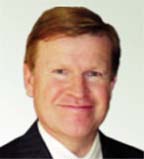– Harold James is Professor of history and international affairs at the Woodrow Wilson School, Princeton University, Professor of history at the European University Institute, Florence and author of The Roman Predicament.
This article was received from Project Syndicate, an international not-for-profit association of newspapers dedicated to hosting a global debate on the key issues shaping our world.
By Harold James

PRINCETON – Public debate, especially during economic crises, focuses on growth statistics, which become a kind of fever thermometer. But the readings are unreliable and change constantly, prompting statisticians to think about different ways of measuring an economy’s very different products. In particular, newly revised data have called into question the economic scope and role of financial services.
At the end of July, the United States Bureau of Economic Analysis released revisions to American GDP data going back to 1929. The main consequence was to demonstrate that GDP is more volatile than had previously been assumed.
The economy grew faster in good phases, and slumped more sharply in downturns. The annual growth rate from 1997 to 2008 was 2.8% rather than 2.7%. In 2008, the figure fell to 0.4%, rather than 1.1%, as previously assumed. The collapse in GDP in the first quarter of 2009 was also more substantial than previously thought.
The logic underlying these changes is more interesting than the relatively small revisions of growth rates that resulted. One key intention was to allow for more honest accounting. In particular, spending on financial services was treated in a different way and shown more transparently. For example, medical expenditure is lower in the new calculation, because the costs that are attributable to insurance rather than to provision of medical services are now shown as spending on “financial services and insurance.”
The new calculation makes it clearer than before how dramatically financial services expanded over the past decade. Spending on financial services roughly doubled between 1998 and 2007, now amounting to 8.2% of personal consumption – a figure that includes the income that is transferred from consumers to the now notorious bonuses of bankers and traders.
The response to the current crisis is not likely to be a halt to financial innovation, but it is likely to cause rationalization and cost-cutting in the provision of financial services. There are clear historical precedents for reining in over-exuberant and over-innovative sectors. In the nineteenth century, an orgy of railroad building created duplicating lines, before severe cyclical downturns purged many of the companies, leaving a leaner and cheaper network. Similarly, in the early twentieth century, many entrepreneurs moved into automobile production. Only a handful of the most efficient producers survived the collapse of the initial boom.
Many countries, including the US, have banking systems that are still overly complex. It is also now clear that financial products themselves were overly complex and that most if not all customers did not know what they were buying.
Traditionally, banks were “black boxes,” in which operations were concealed from customers. The bank knew more about where its money went than its depositors and creditors did. Investment banks gave advice to corporations on mergers and acquisitions, but also issued securities and conducted their own proprietary trading. While so-called “Chinese walls” separated these activities, in practice market participants assumed some degree of leakage, and expected better returns from dealing with big banks, with their multifaceted, international operations. Thus, each counterparty in these transactions assumed that they were getting something special from the accumulated insights that the bank had acquired from its other branches of business, insights that derived fundamentally from permanent conflicts of interest.
The genius of securitization, the great financial innovation of the 1990’s, was that it allowed investors – in theory – to bypass non-transparent black-box banks. Securities took the place of traditional bank credits. But banks used the innovation to place transparent securities in highly opaque “investment vehicles.” Banks’ black-box character survived, and became an even greater source of vulnerability. After all, black boxes are most lethal when they conceal a malevolent or fraudulent human being.
It is possible to imagine that in the longer term finance will become less prone to problems of asymmetrical information, which demand a high level of confidence on the part of depositors and investors in order to reduce the risk of panic and crisis. But finance will no longer be our master only if there is no need for “insiders,” and that requires both transparency and the spread of financial knowledge. In the future, conflicts of interest might be handled by mathematical algorithms that authorize or prohibit transactions. In the same way that automated payment mechanisms have rendered trading floors mostly obsolete, many banking functions can and will become simply an interaction of software systems.
As in previous transitional phases, when innovation leads to cost-saving, individuals who work in the financial industry will try to produce convincing arguments about why their business depends on the human touch. Harvesting machines were alleged to lower the quality of the grain collected, because it was no longer subject to immediate inspection by the human eye. Likewise, advanced automobile plants are now largely composed of robots, and their products are safer than ever.
A personal banker is a status symbol, but nothing more, and certainly not a necessity. The “Monday morning car” – caused by an early and error-prone production run of a new model – is rapidly becoming a thing of the past. Its equivalent in the financial world should meet the same fate.




